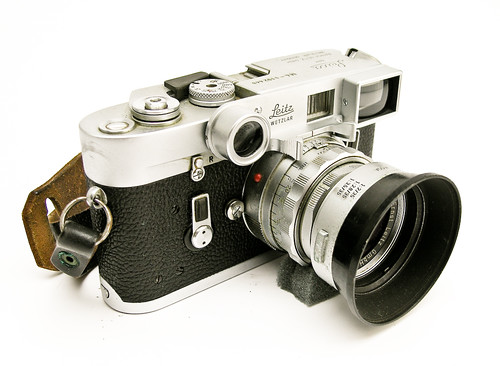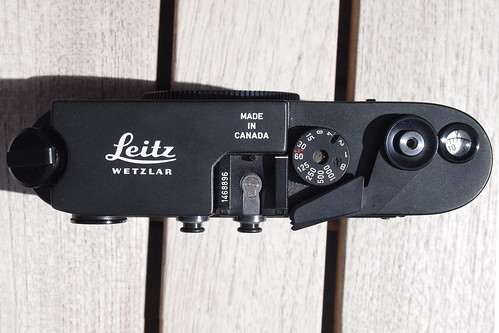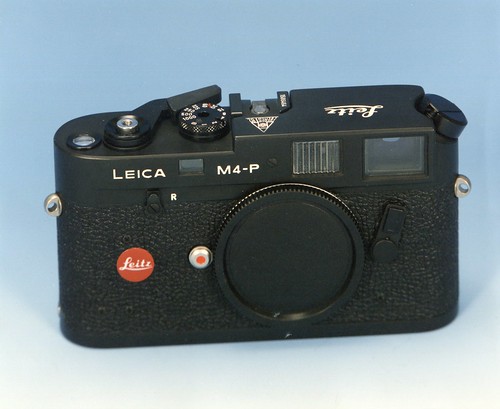Difference between revisions of "Leica M4"
(Merge article, refine layout) |
(Layout) |
||
| Line 32: | Line 32: | ||
The M4 was Leica's last camera produced largely with hand assembly. | The M4 was Leica's last camera produced largely with hand assembly. | ||
| + | |||
| + | ===Film handling=== | ||
| + | Loading and rewinding film was made much easier. A redesigned take up spool simplified film loading, and a crank in place of the earlier knob made rewinding easier and faster. | ||
{{br}} | {{br}} | ||
| − | == | + | ==M4-2== |
{|class=floatright | {|class=floatright | ||
| | | | ||
| Line 61: | Line 64: | ||
{{br}} | {{br}} | ||
| − | == | + | ==MD-2== |
{|class=floatright | {|class=floatright | ||
| | | | ||
| Line 76: | Line 79: | ||
{{br}} | {{br}} | ||
| − | == | + | ==M4-P== |
{|class=floatright | {|class=floatright | ||
| | | | ||
Revision as of 17:54, 16 January 2013
| Leica M4 |
|---|
|
Maker: Leica Dates: M4 1967-1972, M4-2 1977-1983, M4-P 1980-1985 Variants: M4 silver-black, M4-2/M4-P black Camera Type: 35mm rangefinder system Focusing: manual Viewfinder: Reverse Galilean (×0.68)
Rangefinder: coupled, combined (ERB = 47.1mm) Lens mount: Leica M Shutter: focal plane Exposure meter: None Exposure modes: manual ASA/ISO range: 160 to 2500 ISO Shoe: fixed (hotshoe from M4-2) Synchronized: X X sync speed: 1/50 TTL Flash: No Motor drive: No (motor winder from M4-2) Battery: None Dimensions: 138×77×38mm Weight: 550g Number produced: unknown |
The Leica M4 was introduced in 1967, replacing the 1954 Leica M3 with a number of improvements; particularly much improved film handling and viewfinder bright lines for wide angle lenses.
Like the M3, the M4 is an all mechanical manual exposure rangefinder camera without a built in exposure meter.
The M4 was Leica's last camera produced largely with hand assembly.
Contents
Film handling
Loading and rewinding film was made much easier. A redesigned take up spool simplified film loading, and a crank in place of the earlier knob made rewinding easier and faster.
M4-2
| ||
|
Following the disastrous M5, the M4 was reintroduced in 1978 as the M4-2 manufactured in Canada, with only detail differences. Manufacture was simplified and largely mechanised, reducing the very high cost of earlier production.
For the first time provision was made for a motor winder which would fit all subsequent M cameras up to the M7 (but not the earlier M5).
MD-2
|
Like the earlier MD variant of the M3, the MD-2 was a version of the M4-2 without a viewfinder intended primarily for scientific use on a microscope or telescope.
M4-P
|
Built from 1980 to 1986, with serial numbers from 1543351 to 1692950, successor to the M4-2 and likewise made in Canada. The main difference is six viewfinder frames for 28/35/50/75/90/135 lenses by displaying the following combinations: 35/135mm, 50/75mm, and 28/90mm. 28mm and 75mm frames were added for newer lenses. The M4-P also has the .72 magnification viewfinder found in the M6 and available for the M7.
Most M4-Ps were finished in black chrome, while some silver-chrome units were also available. M6 started production in 1984, overlapping production of the M4-P, and later M4-Ps shared the same rangefinder as the M6.
Links
- Leica M4-2 at Sylvain Halgand's www.collection-appareils.fr
- Leica M-series guide at Stephen Gandy's CameraQuest




